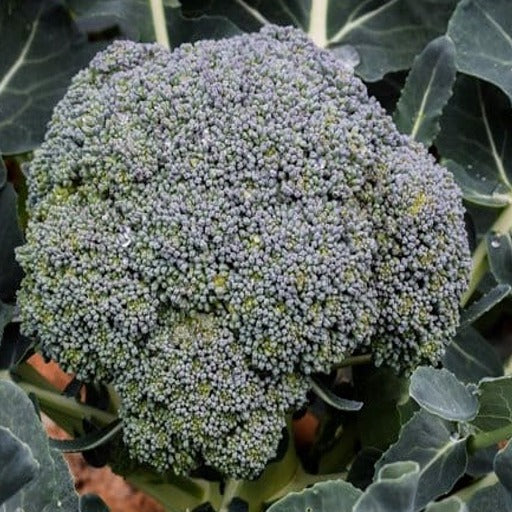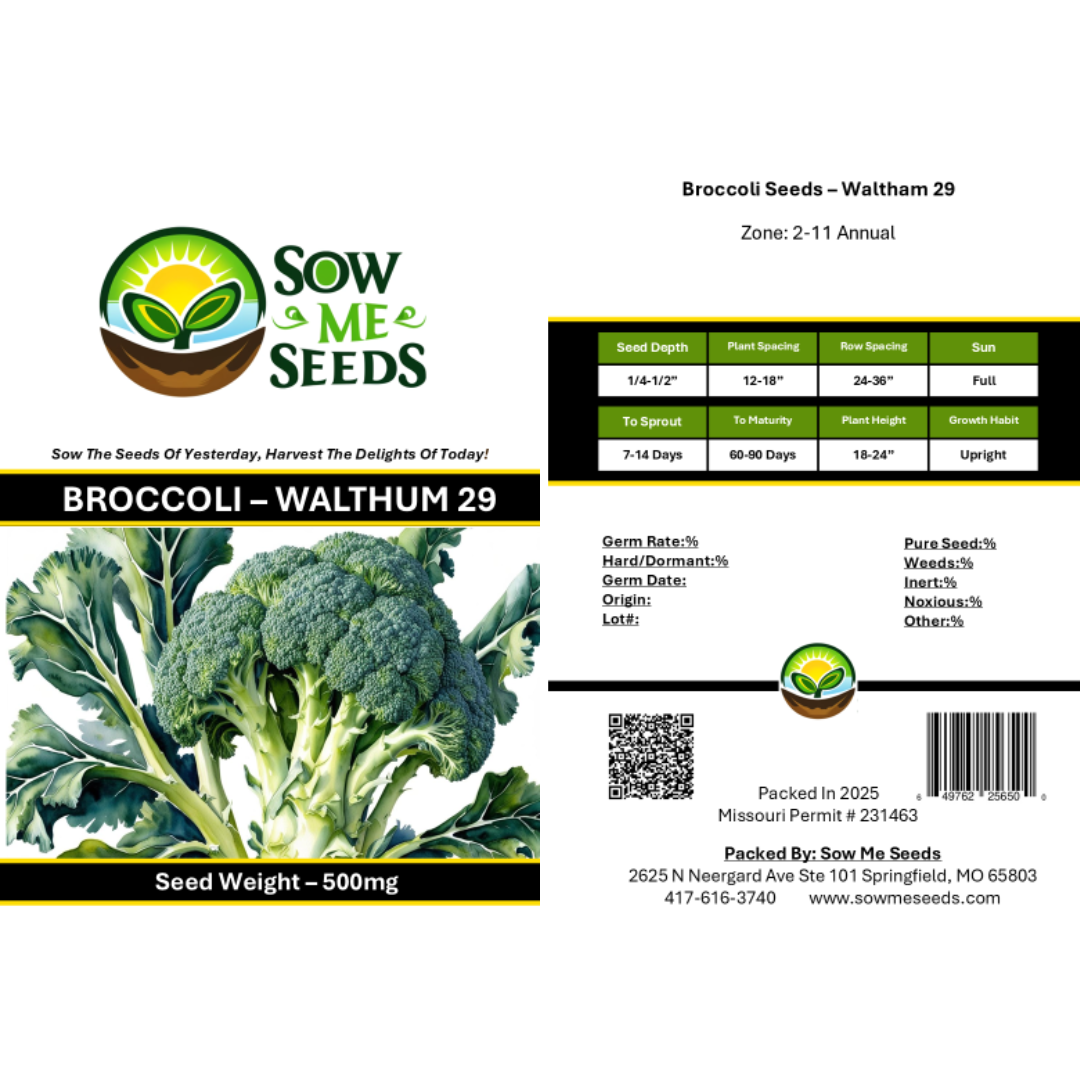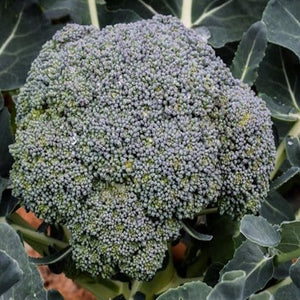- Hardiness Zone: 2-11 Annual
- Grow As Microgreens: Waltham 29 Broccoli Microgreens
Seed Depth: 1/4–1/2 inch
Seed Spacing: 18–24 inches
Row Spacing: 24–36 inches
Sunlight: Full sun to partial shade
Days to Sprout: 7–14 days
Days to Maturity: 85–100 days
Growth Habit: Upright
Sunlight: Choose a location that receives full sun for at least 6-8 hours a day.
Soil: Prefers well-drained, fertile soil with a pH between 6.0 and 7.5. Amend the soil with compost or well-rotted manure to enhance fertility and drainage.
When to Plant: Broccoli is a cool-season crop that can be planted in early spring or late summer for a fall harvest. Start seeds indoors 6-8 weeks before the last expected frost date for a spring crop, or sow seeds directly in the garden in late summer for a fall crop.
Starting Indoors: Sow seeds 1/4 inch deep in seed-starting mix. Keep the soil moist and maintain a temperature of 60-70°F (15-21°C). Transplant seedlings outdoors when they have 4-6 true leaves and the danger of frost has passed.
Direct Sowing: Sow seeds directly in the garden 1/2 inch deep and 3 inches apart in rows spaced 18-24 inches apart. Thin seedlings to stand 12-18 inches apart once they are a few inches tall.
Succession Planting: Sow seeds every 2–3 weeks for a continuous harvest.
Watering: Keep the soil consistently moist but not waterlogged. Water broccoli regularly, especially during dry periods. Mulch around the plants to retain soil moisture and suppress weeds.
Fertilization: Broccoli is a heavy feeder. Apply a balanced fertilizer or compost at planting time and again when the plants are 3-4 weeks old. Side-dress with compost or a balanced fertilizer when heads begin to form.
Mulching and Weeding: Apply a layer of mulch around the plants to retain soil moisture, suppress weeds, and keep the soil temperature consistent. Hand-pull weeds carefully to avoid disturbing the shallow roots of the broccoli.
Pruning: Remove yellowing or damaged leaves to maintain airflow and reduce disease risk.
Pest and Disease Management: Watch for common pests such as aphids, cabbage worms, and flea beetles. Use organic pest control methods like neem oil, insecticidal soap, or hand-picking to manage infestations. Practice crop rotation and ensure good air circulation to prevent fungal diseases like downy mildew and clubroot.
When to Harvest: The main head is typically ready to harvest 85-100 days after planting. Harvest when the head is firm and tight, before the individual florets begin to open.
How to Harvest: Use a sharp knife to cut the main head, leaving about 6 inches of the stem. After harvesting the main head, the plant will produce multiple side shoots, which can be harvested regularly.
Storing Fresh Broccoli: Freshly harvested broccoli can be stored in the refrigerator for up to a week. Place the heads in a plastic bag or container to retain moisture.
Culinary Uses: Broccoli can be steamed, boiled, roasted, or sautéed. It's a versatile vegetable that can be used in stir-fries, soups, salads, casseroles, and as a nutritious side dish.
Why You’ll Love It
Cool-Season Favorite: Performs best in fall but also works well in spring gardens.
Tight Heads: Compact, dome-shaped heads with rich green color and dense florets.
Side Shoots Galore: After the main head is harvested, plants continue to produce tasty side shoots.
Flavorful & Nutritious: Mild, slightly sweet flavor packed with vitamins.
Plant Characteristics
Height: 18–24 inches
Growth Habit: Upright with sturdy stems and branching side-shoots
Head Type: Medium-sized, dome-shaped heads followed by smaller side shoots
Days to Maturity: 70–85 days
Hardiness: Cool-season biennial grown as an annual
Flavor and Culinary Uses
Flavor: Mild and slightly sweet with tender, compact florets
Culinary Uses: Great for steaming, roasting, stir-fries, casseroles, and freezing for later use
Companion Planting Tips
Good Companions: Beets, onions, celery, and chamomile
Avoid Planting Near: Tomatoes, strawberries, and pole beans
Bonus Benefit: A cool-weather crop that helps extend your harvest season
Common Issues and Solutions
Buttoning (Small Heads): Avoid stress — plant early or late in the season and maintain even moisture
Aphids or Cabbage Worms: Use row covers or natural predators like ladybugs and parasitic wasps
Yellowing Leaves: Apply balanced fertilizer and ensure proper drainage
Seeds Per Packet
| 500mg | Approximately 160 |
| 2g | Approximately 640 |
Why You’ll Love It
Cool-Season Favorite: Performs best in fall but also works well in spring gardens.
Tight Heads: Compact, dome-shaped heads with rich green color and dense florets.
Side Shoots Galore: After the main head is harvested, plants continue to produce tasty side shoots.
Flavorful & Nutritious: Mild, slightly sweet flavor packed with vitamins.
Plant Characteristics
Height: 18–24 inches
Growth Habit: Upright with sturdy stems and branching side-shoots
Head Type: Medium-sized, dome-shaped heads followed by smaller side shoots
Days to Maturity: 70–85 days
Hardiness: Cool-season biennial grown as an annual
Flavor and Culinary Uses
Flavor: Mild and slightly sweet with tender, compact florets
Culinary Uses: Great for steaming, roasting, stir-fries, casseroles, and freezing for later use
Companion Planting Tips
Good Companions: Beets, onions, celery, and chamomile
Avoid Planting Near: Tomatoes, strawberries, and pole beans
Bonus Benefit: A cool-weather crop that helps extend your harvest season
Common Issues and Solutions
Buttoning (Small Heads): Avoid stress — plant early or late in the season and maintain even moisture
Aphids or Cabbage Worms: Use row covers or natural predators like ladybugs and parasitic wasps
Yellowing Leaves: Apply balanced fertilizer and ensure proper drainage
Seeds Per Packet
| 500mg | Approximately 160 |
| 2g | Approximately 640 |





Share and get 15% off!
Simply share this product on one of the following social networks and you will unlock 15% off!